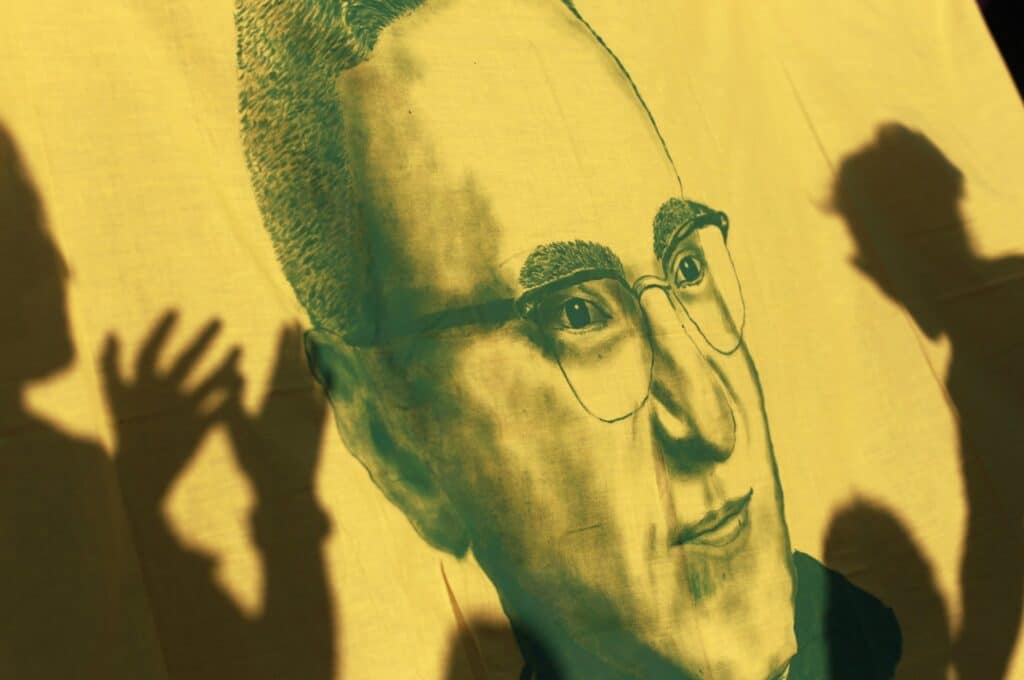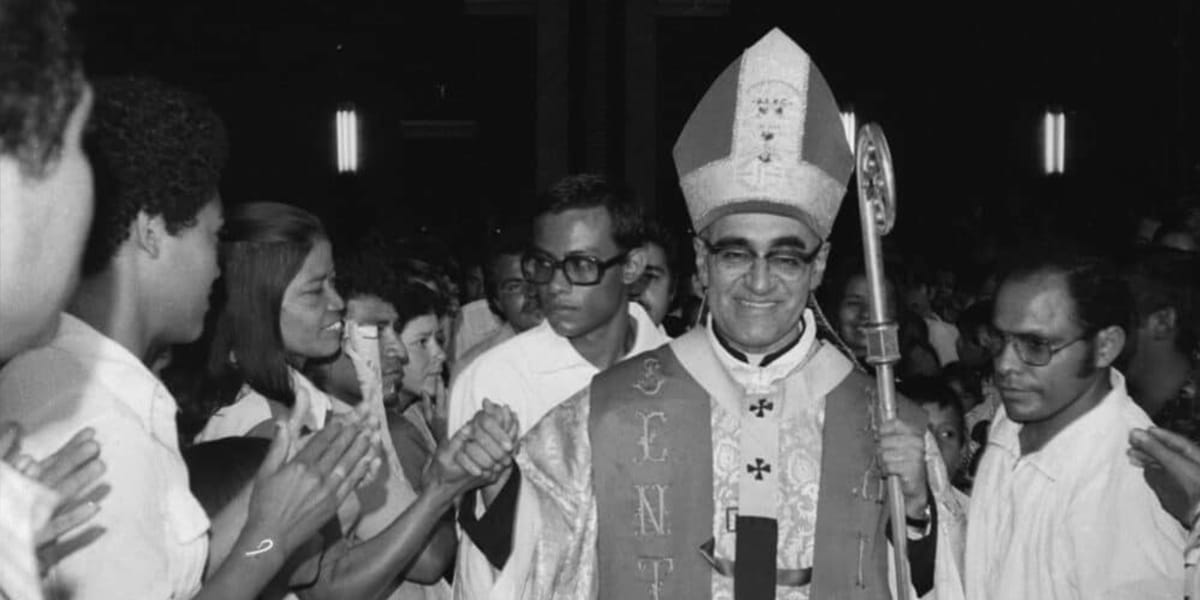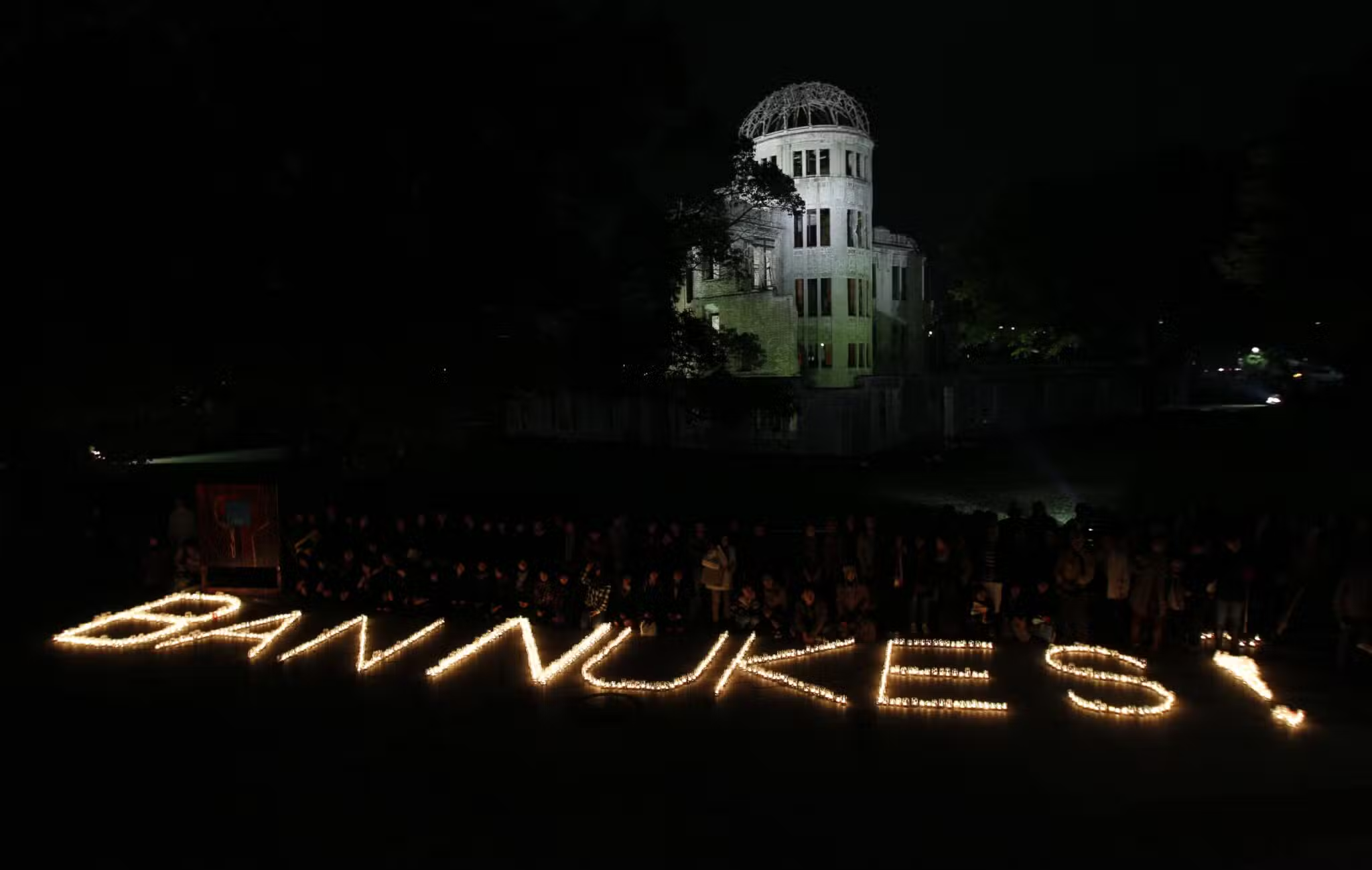His cause for sainthood was blocked for decades. Now the Church has beatified this Salvadoran archbishop.
“They shot Romero! They shot Romero!”
“When I first heard those words shouted down the hallway of our convent in December 1980, I thought, Who is this guy? He must be important. I’ve got to learn about him, as I need guidance for my vocation,” says Sister Rebecca Trujillo, SNDdeN, of New Mexico.
“I became impressed by this Salvadoran archbishop’s humble way of being with and listening to the poor that transformed his life and ministry.
“He could see the root of evil and oppression. Romero realized how our own actions really make a difference. So I prayed, asking him to help me discern my mission that inspired me to 20 years of organizing programs for [people with] special needs and oppressed women and children in Nicaragua. Those words, ‘They shot Romero,’ set my way to be.”
Sister Rebecca is just one of millions who have been empowered by Archbishop Oscar Romero’s option for the oppressed. And it was that Christ-like example also that inspired Pope Francis to have him beatified on May 23.
A Faith in Process
Born in Ciudad Barrios, El Salvador, in 1917, Oscar Romero was trained by his father to be a carpenter, but he went on to the seminary and later studied in Rome for a licentiate in theology. After his ordination there in 1942, Romero returned to El Salvador to serve as a pastor for 20 years, eventually becoming a seminary rector. He served the Salvadoran bishops’ conference and directed a fairly conservative archdiocesan newspaper.
On February 23, 1977, Romero was appointed archbishop of San Salvador, much to the relief of the junta government and the aristocracy, who saw him as an ally. Two percent of the population owned 60 percent of the land, and 14 families were said to own the country. Those in power were worried about the rising movement of liberation theology. (Essentially this is a theology that asserts that God has a preferential option for the poor, and that people of faith need to transform social, government, and economic systems that keep people poor.)
A few weeks after Romero was installed as the new archbishop, his friend Father Rutilio Grande, SJ, was brutally killed with companions for organizing Salvadoran peasants. The government failed to investigate. After this stunning experience, Romero then fully committed himself to walk the same path—a major, personal transformation in the Spirit.
Through sermons, radio broadcasts, processions, and the like, this once-timid archbishop began to denounce the government’s rapidly growing violence, building a massive local and global following. By February 1980, Romero wrote to US President Jimmy Carter, strongly urging him to end military support to the Salvadoran junta. His pleas were ignored, and over the next number of years, the Reagan administration would direct roughly a million dollars per day to the military regime. This led to the killing of 100,000 and, some believe, as many as 300,000 Salvadorans—one of the longest and bloodiest conflicts in our hemisphere.
The Ultimate Sacrifice
On March 23, 1980, Archbishop Romero delivered a now-famous homily ordering soldiers to stop killing their own countrymen. “It is time to regain your conscience. In the name of God and the name of the suffering people, I implore you, I beg you, I order you, stop the repression!” The very next day, Romero was shot while celebrating Mass, as plotted by military and other local leaders. Forty people were killed by gunfire and explosions at Romero’s funeral.
This was a turning point that mushroomed into a full-blown war against the poor. Before his assassination, Romero stated, “As a Christian, I do not believe in death without resurrection. If I am killed, I shall rise in the Salvadoran people.” His words are still chanted today, “They can kill me, but they will never kill justice.”

Some have speculated that, in the past, some Salvadoran bishops and popes have been slow to work toward Romero’s beatification process because of his affiliation with liberation theology, and/or that he was killed for mostly political reasons. However, one month after Pope Francis’ March 2013 election, he “unblocked” Romero’s canonization case. As a result, the Holy Father declared on February 3, 2015, that the Salvadoran archbishop was killed as a martyr for the Catholic faith, which meant there was no need to prove a miracle for his beatification. This is the last step before sainthood.
Speaking for Pope Francis, Italian Archbishop Vincenzo Paglia, the chief promotor of Romero’s sainthood cause, said Romero’s murder was part of a “climate of persecution against a pastor who followed the evangelical experience, the documents of the Second Vatican Council, of Medellin [Latin American Bishops’ Conference 1968 statement in favor of the poor], and had chosen to live with the poor to defend them from oppression. Romero was killed because of this perspective.”
Who Was This Martyr?
So what did—and does—Romero mean to those who worked with him and know of his life of solidarity? There are posters and T-shirts, all over this hemisphere, especially in Central America, that give him these titles: pastor, prophet, martyr, and now . . . “Saint of the Americas.”
Pastor: At the age of 21, Franciscan Brother Octavio Duran, OFM, of El Salvador met Romero at his archdiocesan seminary, and conducted many radio interviews with him.
Octavio often followed Romero to the villages to photograph visits demonstrating his love for the poor, even though the Salvadoran military would sometimes harass him. Octavio noted that on one of his visits, Romero was shivering with fear as the soldiers approached his jeep with pointed rifles. Later, Octavio observed, “The radio and camera allowed me to better know this friend, pastor, and prophet: as a friend who said he did not fear death, as a pastor who stayed and protected his flock, and as a prophet who decried injustice and oppression the Salvadoran people suffered.” He added, “Romero is a symbol of courage, and as a pastor he gave voice to the voiceless during the time when his archdiocese was persecuted.”
Maryknoll Missioner Father John Spain, who ministered with Romero, and later carried his coffin, notes, “As a pastor, he wanted to get to a fuller grasp of the situation. He was a good listener. He also looked for help from diplomats and Church leaders when a foreign priest was falsely accused and expelled from the country. . . . I felt his support.”
Two valiant Nicaraguan women who developed small Christian Base Communities in their Managua neighborhoods in the 1970s and ’80s still speak of the empowering qualities they learned from the pastoral archbishop in the neighboring country. Doñas Adilia Luna Salina and Nieves Saballos Zapata point out, “By listening to his friend Father Grande, walking with his people as a good pastor, and by being open to the Holy Spirit, Romero changed and got involved! He’s a good example for us as he demonstrated how to ‘capacitate’ people, especially women like us. He showed us how to grow in self-confidence. And he still lives in us!”
In his homily of October 30, 1977, Romero simply stated, “The pastor has to be where there is suffering.”
Prophet: A minister for pastoral social work at Holy Cross Parish in San Salvador, Jose Neris Aria Valladeres, strongly believes that Romero was true prophet “who spoke in the name of God, denouncing injustices being committed against the rights of people, like the many farmers and catechists who were killed for having Bibles.” Aria argues that the archbishop was a prophet because he left the comfortable and the privileged in order to take the side of those who suffered more; consequently, he chose to eat and live more simply.
Romero also chose to speak the truth about the causes of social conflicts and stood in solidarity with the needy, while calling for the forgiveness and reconciliation of Christ. “He cared for his sheep, obeyed God, prayed to Mary, and loved God’s word,” says Aria. He adds, “Romero has inspired me to offer my life in service to the local homeless to help deliver them from the darkness of life.”
Ren Austing and his fellow parishioners of St. James of the Valley Church in Wyoming, Ohio, have had a 20-year sister community relationship with a Christian Base Community in El Salvador. Ren and his wife adopted a Salvadoran child years ago, who is now 22 years old. “This experience has greatly expanded our definition of family,” notes Austing.
“Romero for me is a prophet of love, integrity, faith, patience, and healing. With humble listening to the poor and prayer, he transformed his perspective of how the Gospel needed to be lived, which led him to be an outspoken and active presence,” writes Austing.
He adds, “Romero is present-day proof that the Gospel works in our lives and is as relevant today as it was 2,000 years ago, and that its fruits are peace and joy. Resurrection, i.e., defeat of death, is real. He’s a model to emulate in his prayer life and devotion. He is a challenge to me to improve my internal discipline and prayer life that I struggle with. He is also a model of the Church being open and guided by the Spirit.”
How has Romero impacted him and his parish? Austing said he made one of his fact-finding mission trips to El Salvador in 1986 during their horrendous hostilities. This led his parish to join the sanctuary movement to take in Salvadoran war refugees as a way to express their opposition to the US government’s support of the Salvadoran military junta. With their parish partners, they have provided over 400 scholarships to children of their sister community, as well as built a community library and pastoral center with them.
Parishioners are also visiting their US congresspersons to improve economic and social conditions in El Salvador that create the migration of thousands of Salvadorans, and to change our inhumane immigration laws. Austing says that his parish’s relationship with Salvadorans and the life, death, and resurrection of Romero provides pride in our Church that continues to produce saints like Romero, despite all of its flaws of being an institution administered by fallible humans.
Martyr: Salvadoran composer Guillermo Cuellar was commissioned by Archbishop Romero, before his death, to write the nowfamous Misa Popular Salvadoreña. It is based on Cuellar’s work with Romero as a young adult, his reflections with the Christian Base Communities, and his commitment to social justice.
He writes about his martyred friend, “Monsignor Romero was a special human being because he decided to give his life in a conscious way. I think his main legacy is that he taught us to be good Salvadorans, to give the best of our lives for our people. As he said, ‘If you kill me, I will raise up in my people.’ The Salvadoran Catholic Church was the Church that most embodied the ideals of the theology of liberation that Romero embodied himself. Romero lived and decided to give his life like Christ did.”
Msgr. Ricardo Urrioste served as vicar general for St. Archbishop Romero in San Salvador and was his close friend and confidant. He was asked, “Was Romero being manipulated by the Communists or other groups?” Urrioste replied, “Yes. He was manipulated by God. He was a man of prayer, a Churchman who greatly loved the poor.” While some have claimed that Romero was a Marxist, Urrioste points out that after theologians in the Vatican and the pope read his writings and homily, they declared him a Church martyr.
Romero’s Legacy
Urrioste asserts that this was his legacy: “He was a man who sought God, a man who had the courage to be the voice of the voiceless in Salvador when there was so much outrage, so much death, and no one said anything except him.” He spoke up for “the respect for the human person created in the image and likeness of God.”
Cardinal Oscar Rodriguez of Honduras frequently points to the importance of the Eucharist as part of Romero’s heritage. He explains how both the archbishop understood and Pope Francis understands today that Jesus truly comes to each of us in the breaking and sharing of the bread, his body. This sharing of the life of Jesus, says Rodriguez, should lead us to practical solidarity, to be custodians of the earth, to seek the common good, and to go out as missionary disciples from our parishes.
“God helps us to multiply what we are willing to share,” he says. He adds, “The Holy Father calls us ‘to have the smell of the sheep’— to be among the poor, to change the world by being with those who suffer most, which Romero did so well.
“Romero had a dream that we must build together,” proclaims the cardinal, who heads Pope Francis’ Council of Cardinals. “Economic globalization is dehumanizing us. However, “Romero offers us a profile of holiness and commitment to the youth to construct a more just and humane world. It is not fair that the only commodities that we can export are illegal immigrants because there are no sources of work or horizons of hope for the poor.”
Rodriguez sums up the sentiments of Latin Americans and now the worldwide Church: “We must overcome the culture of death, and overcome evil with good. Let us continue our commitment for a more just and peaceful world with the power of the resurrected Christ and motivating presence of Romero!”








